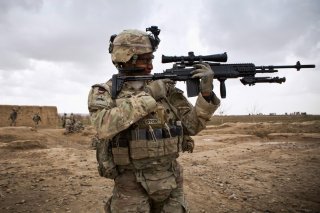How the Army Is Trimming Its Budget By Evolving Its Weapons
Advanced technologies can save money.
The pace of evolving technology and its implications for weapons systems continues to introduce new, paradigm-changing tactics for war planners.
Many of these technologies, some of which emerge due to extensive research and development funding and innovative thinking, could save the Defense Department billions of dollars too. The idea is to generate operational efficiency and financial efficiency.
Army Secretary Christine Wormuth highlighted this concept when asked about costs associated with new weapons platforms following the conclusion of the Army’s Project Convergence 21 experiment. The overall thrust of the experiment was to exponentially increase the speed of decisionmaking on the battlefield and reduce sensor-to-shooter time to stay ahead of or “inside of” an enemy’s decision cycle.
Wormuth first focused on the paradigm-changing tactical benefit and strategic importance of many of the new systems explored during the experiment. Then, she made the point that, in many cases, advanced technologies can save money. Also, streamlining technological efficiency and pursuing performance breakthroughs can lead to substantial long-term budget advantages. Wormuth indicated that the two things are not mutually exclusive when talking about new technologies that integrate otherwise disconnected nodes and weapons systems.
“A lot of this is actually looking at how we use data, how you use software and how we use algorithms to help us better connect sensors to shooters. So, I actually think there’s potential for us to actually have some offset savings,” Wormuth said, according to an Army transcript.
Engineers are making advances in computing and software upgrades. These upgrades can streamline systems and ultimately reduce their hardware footprint. Smaller form factors can weigh less, be more efficient and prove to be valuable on the battlefield. But also, they can minimize the need for manpower and possibly save money by reducing redundant hardware systems and enabling the removal of larger, less efficient systems that are costly to maintain.
“The more we can move from eight, you know, ways to look at the battlefield to four pictures of the battlefield to finally one picture of the battlefield,” Wormuth said. “We then won’t need as many people to do that. We may be able actually to get rid of some of our Legacy [information technology] systems and things like that as we bring online some of these new things. So I think there’s potential there for savings frankly.”
There are many examples of this, some of which are very large scale. The amount of computer automation used by the Navy to operate Ford-class carriers allows the service to deploy the ship with roughly nine hundred fewer sailors on board. Procedural functions such as equipment monitoring, data collection and even the operations of certain ship systems can safely and efficiently be done by computers. Navy developers have long said that this automation can save as much as $4 billion over the life of the ship. Thus, it can reshape war to ensure overmatch against enemies in the future and achieve high levels of cost savings.
The same can be said of the Army’s vehicle integration networking system, known as VICTORY. The intelligence, surveillance and reconnaissance system has been under development for many years. It connects sensors and other systems to one another on a common network to streamline and organize data from otherwise disconnected equipment nodes. Although it is primarily oriented toward improving mission execution by organizing data, it also reduces the amount of equipment each vehicle requires.
Kris Osborn is the defense editor for the National Interest. Osborn previously served at the Pentagon as a Highly Qualified Expert with the Office of the Assistant Secretary of the Army—Acquisition, Logistics & Technology. Osborn has also worked as an anchor and on-air military specialist at national TV networks. He has appeared as a guest military expert on Fox News, MSNBC, The Military Channel, and The History Channel. He also has a Master’s Degree in Comparative Literature from Columbia University.
Image: Reuters

